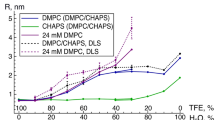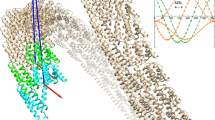Abstract
A new computer-aided molecular modeling approach based on the concept of three-dimensional (3D) molecular hydrophobicity potential has been developed to calculate the spatial organization of intramembrane domains in proteins. The method has been tested by calculating the arrangement of membrane-spanning segments in the photoreaction center ofRhodopseudomonas viridis and comparing the results obtained with those derived from the X-ray data. We have applied this computational procedure to the analysis of interhelical packing in membrane moiety of Na+, K+-ATPase. The work consists of three parts. In Part I, 3D distributions of electrostatic and molecular hydrophobicity potentials on the surfaces of transmembrane helical peptides were computed and visualized. The hydrophobic and electrostatic properties of helices are discussed from the point of view of their possible arrangement within the protein molecule. Interlocation of helical segments connected with short extramembrane loops found by means of optimization of their hydrophobic/hydrophilic contacts is considered in Part II. The most probable 3D model of packing of helical peptides in the membrane domain of Na+, K+-ATPase is discussed in the final part of the work.
Similar content being viewed by others
References
Audry, E., Dubost, J. P., Colleter, J. C., and Dallet, P. (1986).Eur. J. Med. Chem.-Chim. Ther. 21, 71–72.
Brasseur, R. (1988).J. Biol. Chem. 263, 12,571–12,575.
Brasseur, R., De Loof, H., Ruysschaert, J. M., and Rosseneu, M. (1988).Biochim. Biophys. Acta 943, 95–102.
Brasseur, R. (1991).J. Biol. Chem. 266, 16,120–16,127.
Connolly, M. L. (1983).Science 221, 709–713.
Cornette, J. L., Cease, K. B., Margalit, H., Spouge, J. L., Berzofsky, J. A., and DeLisi, C. (1987).J. Mol. Biol. 195, 659–685.
Deisenhofer, J., Epp, O., Miki, K., Huber, R., and Michel, H. (1985).Nature 318, 618–624.
Eisenberg, D., Schwarz, E., Komaromy, M., and Wall, R. (1984).J. Mol. Biol. 179, 125–142.
Eisenberg, D., and McLachlan, A. D. (1986).Nature 319, 199–203.
Fasman, G. D. (1989). InPrediction of Protein Structure and the Principles of Protein Conformation (Fasman, G. D., ed.), Plenum Press, New York, pp. 193–301.
Fauchere, J.-L., Quarendon, P., and Kaetterer, L. (1988).J. Mol. Graphics 6, 203–206.
Furet, P., Sele, A., and Cohen, N. C. (1988).J. Mol. Graphics 6, 182–189.
Gennis, R. B. (1989).Biomembranes: Molecular Structure and Function, Springer, New York.
Ghose, A. K., and Crippen, G. M. (1986).J. Comput. Chem. 7, 565–577.
Goldshleger, R., Tal, D. M., Moorman, J., Stein, W. D., and Karlish, S. J. D. (1992).Proc. Nat. Acad. Sci. (in press).
Gruschus, J. M., and Kuki, A. (1990).J. Comput. Chem. 11, 978–993.
Henderson, R., Baldwin, J. M., Ceska, T. A., Zemlin, F., Beckman, E., and Downing, K. H. (1990).J. Mol. Biol. 213, 899–929.
Honig, B. H., Hubbel, W. L., and Flewelling, R. F. (1986). InAnnual Review of Biophysics and Biophysical Chemistry (Engelman, D. M., Cantor, C. R., and Pollard, T. D., eds.), Vol. 15, Ann. Rev. Inc., Palo Alto, California, pp. 163–193.
Jorgensen, P. L., and Andersen, J. P. (1988).J. Membr. Biol. 103, 95–120.
Kyte, J., and Doolittle, R. F. (1982).J. Mol. Biol. 157, 105–132.
Lesser, G. J., and Rose, G. D. (1990).Proteins 8, 6–13.
Modyanov, N. N., Lutsenko, S. V., Chertova, E. N., and Efremov, R. G. (1990). InThe Sodium Pump: Structure, Mechanism, and Regulation (Kaplan, J. H., and De Weer, P., eds.), Vol. 46, Rockfeller University Press, New York, pp. 99–115.
Modyanov, N. N., Lutsenko, S. V., Chertova, E. N., Efremov, R. G., and Gulyaev, D. I. (1992).Acta Pysiol. Scand. (in press).
Ovchinnikov, Yu. A., Arystarkhova, E. A., Arzamazova, N. M., Dzhandzhugazyan, K. N., Efremov, R. G., Nabiev, I. R., and Modyanov, N. N. (1988).FEBS Lett. 227, 235–239.
Pullman, A. (1988). InIon Pumps: Structure, Function, and Regulation (Stein, W., ed.), Alan Liss, New York, pp. 113–120.
Rees, D. C., De Antonio, L., and Eisenberg, D. (1989).Science 245, 510–513.
Robson, B., and Garnier, G. (1988).Introduction to Proteins and Protein Engineering, Elsevier, Amsterdam, pp. 155–194.
Tanford, C. (1980).The Hydrophobic Effect, Wiley, New York.
Viswanadhan, V. N., Ghose, A. K., Revankar, G. R., and Robins, R. K. (1989).J. Chem. Inf. Comput. Sci. 29, 163–172.
Walian, P. J., and Jap, B. K. (1990).J. Mol. Biol. 215, 429–438.
Wang, J., and Pullman, A. (1991a).Chem. Phys. Lipids 57, 1–16.
Wang, J., and Pullman, A. (1991b).Biochim. Biophys. Acta 1070, 493–496.
Author information
Authors and Affiliations
Rights and permissions
About this article
Cite this article
Efremov, R.G., Gulyaev, D.I., Vergoten, G. et al. Application of three-dimensional molecular hydrophobicity potential to the analysis of spatial organization of membrane domains in proteins: I. Hydrophobic properties of transmembrane segments of Na+, K+-ATPase. J Protein Chem 11, 665–675 (1992). https://doi.org/10.1007/BF01024968
Received:
Published:
Issue Date:
DOI: https://doi.org/10.1007/BF01024968




